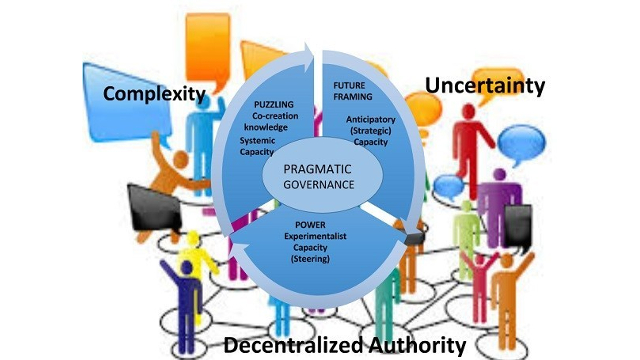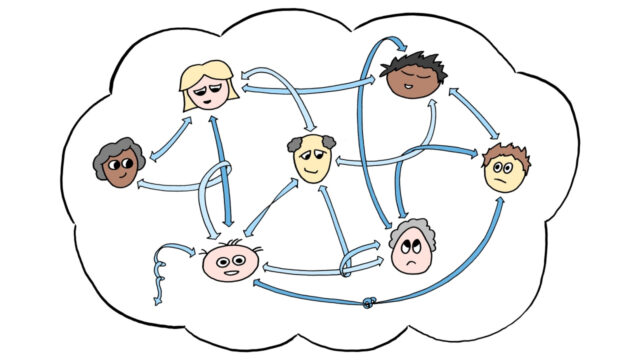
Exploring the science of complexity series (part 7): Origins of complexity sciences
This article is part 7 of a series of articles featuring the ODI Working Paper Exploring the science of complexity: Ideas and implications for development and humanitarian efforts.
In scientific efforts to investigate natural phenomena, some of the most longstanding conceptual and methodological issues have centred on natural systems that undergo sudden, unexpected and disorderly change1. Scientists could use systematic methods to understand the elements making up water, the structure of a water molecule and the different physical states of water, but it was much harder to apply a similar approach to understanding the dynamics of change present in a whirlpool or a change in the climate. Not only were the required methods and tools not available until relatively recently, but also their form was beyond the imagination of most thinkers2. The unspoken consensus was that these questions could not, in fact, be answered, and that any attempt was doomed to frustration and failure.
In a work widely acknowledged as helping to popularise an understanding of perhaps the most famous element of complexity – namely, chaos – science journalist James Gleick3 describes how, in the 1960s and 1970s, a scattered group of scientists in the US and Europe started to investigate ways to understand and explain disorder and change. The most famous of these was Edward Lorenz, whose ‘butterfly effect’ is still the strongest metaphor for chaos in the public imagination. The butterfly effect demonstrated how small differences at the outset of an experiment – such as a butterfly flapping its wings – could lead to massive differences at a later stage – such as storms raging over New York.
The work of Lorenz was crucial because it was an early – and highly influential – step in illuminating a world of nonlinear dynamics. This world was an important addition to Newton’s reductionist model of a predictable and orderly universe. Under Newtonian principles, analysing complex phenomena first involves dividing it into component parts, then explaining the behaviour of these parts, and then aggregating these partial explanations into an understanding of the whole. In contrast, Lorenz’s approach involved understanding phenomena by analysing patterns in a system’s behaviour as a whole. Under certain conditions, even the most insignificant agent has some influence on the system, influencing the initial conditions and ensuring that things never happen in the same way twice (personal communication with Alim Khan, 2007). Deterministic modes of thinking, in which the future is seen as a straightforward extrapolation of past trends, were reassessed in light of this discovery. Those conditions to which deterministic thinking could not be applied were scrutinised using a new set of concepts and ideas – which were increasingly referred to as complexity science4.
In the following years, researchers were able to use new technologies and analytical frameworks to help strengthen understanding of processes and data that did not fit existing theories and models. The irregular side of nature – the discontinuous and erratic side – had been a puzzle to science, but illumination was occurring rapidly by means of the new science of complexity. We will come later to the distinct concepts of complexity; suffice it to say here that these concepts were elaborated in a range of different settings but shared a very precise definition in terms of the mathematical relationships between the elements of the system under study. Showing that these relationships applied to a range of physical phenomena was the first step in moving chaos theory from a matter for curious interest to the basis of new efforts for understanding dynamic change processes.
The tools of complexity science and chaos found their early articulation within the physical sciences. However, once developed, scientists started to see similar processes everywhere – not just in the atmosphere, but also in the turbulent sea, in the fluctuations of wildlife populations, in the oscillations of the heart and the brain, in the movement of stock markets, and in the movement of traffic.
It is important to reiterate that what is usually referred to as complexity science is actually a collection of ideas, principles and influences from a number of other bodies of knowledge, including chaos theory, cybernetics and complex adaptive systems (a term coined by researchers at the Santa Fe Institute) in the natural sciences, postmodernism in the social sciences, and systems thinking, which is found across all sciences.
Systems thinking is particularly close in its origins and scope to complexity science. As we shall see, complexity can only emerge in the context of a system, and certain aspects of complexity, such as feedback, find clear parallels in systems thinking. From the perspective of one of its leading proponents, Peter Senge5, systems thinking focuses on seeing interrelationships rather than linear cause-effect chains, and seeing processes of change rather than snapshots. This leads to a search for certain types of systems structures that recur again and again: the deeper patterns lying behind events and details. In our reading of the literature, the differences vary depending on the perspective of the thinker. Some systems thinkers argue that they have always been focused on complex systems. Some complexity specialists argue that complexity is built on fundamentally different assumptions. Some thinkers have gone so far as to outline the key differences below.
Box 1. Similarities and differences between complexity and systems approaches.
It is worth noting that:
- Systems thinking assumes that systems have dominant rules that can be used to calculate potential equilibrium, whereas complexity emphasises that systems tend to defy calculated equilibrium.
- Systems thinking sees that systems have some kind of ‘control system’ that provides guidance and shapes the system, whereas complexity recognises the possibility of self-organisation.
- Systems thinking suggests that elements in a system can be understood as isolated elements and symbols, whereas complexity forces us to see the interdependence of the nature/meaning of individual elements and the context in which they are embedded.
- Systems thinking assumes that systems propose rational processes and predictable results, albeit through complicated means, whereas complexity recognises that solutions are arrived at via dynamic processes that are not likely to result in a final conclusion.
- Systems thinking assumes that systems change their structures in accordance with rule-based learning, whereas complexity recognises that change is perpetual, so learning is a constant factor.
For more on this debate, see Haynes6 and Cilliers7.
Next part (part 8): Applications in the social, political and economic realms.
Article source: Ramalingam, B., Jones, H., Reba, T., & Young, J. (2008). Exploring the science of complexity: Ideas and implications for development and humanitarian efforts (Vol. 285). London: ODI. (https://www.odi.org/publications/583-exploring-science-complexity-ideas-and-implications-development-and-humanitarian-efforts). Republished under CC BY-NC-ND 4.0 in accordance with the Terms and conditions of the ODI website.
Header image source: qimono on Pixabay, Public Domain.
References:
- Sanders, I. (1998). Strategic Thinking and the New Science: Planning in the Midst of Chaos, Complexity, and Change, Columbus OH: The Free Press. ↩
- Gleick, J. (1987). Chaos: Making a New Science, New York: Viking. ↩
- Gleick, J. (1987). Chaos: Making a New Science, New York: Viking. ↩
- Sanders, I. (1998). Strategic Thinking and the New Science: Planning in the Midst of Chaos, Complexity, and Change, Columbus OH: The Free Press. ↩
- Senge, P. (1990). The Leader’s New Work: Building Learning Organizations, Sloan Management Review 32(1): 7–23. ↩
- Haynes, P. (2003). Managing Complexity in the Public Services. Berkshire: Open University Press. ↩
- Cilliers, P. (1998). Complexity and postmodernism: Understanding complex systems. New York: Routledge. ↩






